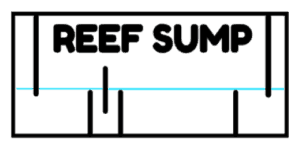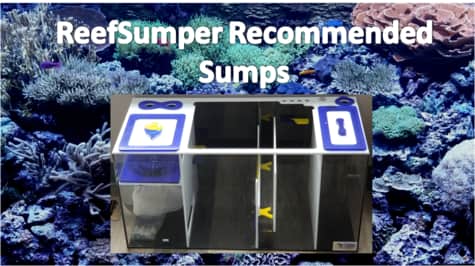
One of the worst things that can happen in the reef aquarium hobby is for your reef tank or sump to overflow water into your stand and on the floor. When this catastrophic event happens, damage to your home and stand can be devastating. Damage to your house and stand is one thing, but a major undetected overflow can also lead to a wipeout of your display tank’s fish and coral. The check valve is a plumbing device that has been used in reef aquariums to help prevent tank and sump overflows.
Is a check valve on a sump return line necessary? A check valve on the sump return line isn’t necessary for an aquarium with a sump. A properly designed aquarium, sump, drain, and return setup will nullify the need for a check valve.
In this article, I explore what a check valve is, how it works, and some of the pros and cons of using a check valve in a reef aquarium setup. I also will outline a better method for ensuring overflow does not happen in your reef tank.
What is a Check Valve?
A check valve is a plumbing device that has two openings and allows water to flow in only one direction, in one opening and out the other. In a typical reef aquarium with a sump, a return pump pulls water from the return section up to the return line and back into the display tank. In the event of an intentional or unintentional power loss, the water moving up the return line will move down and drain back into the sump. In this scenario, a siphon is created at the end of the return line and as long as there is water to pull down in the sump it will continue to do so until it air is sucked into the return breaking the siphon or equilibrium is reached between the tank and your sump. If your sump does not have room to hold water until a siphon break occurs an overflow will happen.
A check valve can be placed between the return pump and the end of the return. As check valves are designed to allow flow in only one direction when the power goes out the check valve will trigger and close, not allowing water to flow down into the sump as it moves down the return line. When it comes to reef aquarium returns there are a few standard check valve options used including inline check valves, y check valves, and Lock-Line check valves.
Inline Check Valves
Inline check valves typically run inline vertically with the return pipe back up to the display tank. These check valves are often set up as true unions meaning they have unions on each side of the check valve which allows you to screw off the check valve for easier maintenance or replacement. Most of these will use a flapper that seals when triggered by water trying to flow down the return pipe. As water is being pushed up through the return line from the return pump the flapper is forced open with the flow of the water and when power is shut off water begins to drain the flapper is pushed down and seals shut stopping water from draining into the return chamber of the sump. Cleaning inline check valves can be a challenge as accessing the flapper is difficult with it being inside the check valve. Maintenance usually includes unscrewing the unions and cleaning the inside of the valve with a pipe brush as best as you can.
Y Check Valves
Y check valves as the name suggest are in the shape of a y. Y check valves use a weighted plunger to close backflow draining into the sump. As water moves up the return it pushes the plunger into the y section of the check valve allowing water to flow back up into the display tank. When the power goes and out and water moves down the return the weighted plunger drops into the check valve stopping the flow of water into the sump. The big advantage of the Y check valve is the ability to easily access the plunger for regular maintenance. The Y check valve usually comes with a screw-on cap that can be taken off for access to the removable plunger. The plunger can then be removed and thoroughly cleaned.
Loc-Line Check Valve
Loc-Line has become a staple in the reef aquarium hobby and is especially used at the end of return lines. Loc-Line is a modular pipe/hose system with many options for different uses in the reef aquarium hobby. The system works by attaching small sections of Loc-Line together to create a pipe that can be bent to direct water flow in the direction you want. Loc-Line has many types of adapters and connections to customize what you want to use it for. Loc-Line easily connects to the end of plumbing and makes a great option to direct flow in your reef tank. One of the adapter options that can be used is a Loc-Line check valve adapter. Loc-Line check valves are comparatively inexpensive and can be placed anywhere in the lock line hose. The Loc-Line check valves work in the same fashion as other check valves by allowing water flow to happen in only one direction.
Issues with Using a Check Valve in the Reef Aquarium
Check valves, in theory, sound like great pieces of plumbing that could save your bacon in an event of power loss and siphon draining back into the sump, however they are not without faults that should be considered when plumbing your return. As with any mechanical device, a failure is possible and will actually happen at some point in its life cycle. If maintenance is not regularly performed on your check valves algae build-up and other aquarium by-products could gunk up the check valve and prevent it from closing or even fully sealing. Even if there is a small leak inside the check valve, with enough time the small leak in the valve could overflow the sump if not caught in time. There is a lot happening in a reef aquarium and life tends to spread anywhere where water is located including in the check valve. A snail could easily make its way into the return and actually block the function of the check valve when it’s needed.
A lot of check valves in the reef aquarium are clear. Being clear is good in the sense that you can see the mechanics of the check valve and visually inspect it for maintenance opportunities. With it being clear though, algae growth is promoted and algae can prevent a full seal when the check valve is triggered.
If you are intent on using a check valve in your system make sure that you are prepared to regularly maintain the device and know that even with regular maintenance there is still the possibility of failure.
Best Way to Prevent Overflow Without a Check Valve?
I find for a typical reef aquarium and sump the check valve is unnecessary and actually another piece in the system that will require maintenance and is an additional point for potential failure in the overall system. Preventing an overflow is very important and actually comes down to proper design as a powerful overflow prevention technique. Two simple considerations can be considered to prevent overflowing in a power outage, the size of your sump and the location of the end of your return or returns.
Remember to stop backflow into the sump during a power outage the end of the return line or lines must suck in air to break the siphon. To accomplish this you want to have the ends of your return line near the top of your display tank’s water line. In most of my setups, I like to use a Loc-Line hose connected to a bulkhead with the end of the Loc-Line nozzle just under the waterline of the display tank. The lower your return line end is into the tank, the more water will be siphoned into the sump when the power goes out. With the end just below the water, air will get sucked into the return breaking the siphon with only a little amount of water going into the sump. Be careful to recognize and readjust if you’ve bumped your return and it becomes lower under the waterline than intended.
The second factor is your sump size. Your sump should be large enough to accept the amount of water from the top of the water line to the point where your return/returns suck in air and break the siphon. To minimize the amount of water siphoned adjust your return ends up closer to the waterline. Some reef keepers will drill a small hole at the top of the return (still underwater) to siphon quicker. I only use this method when moving the end of the Loc-Line isn’t a possibility. I’d rather not rely on a small drilled hole as there is always the possibility that the drilled hole gets clogged preventing a siphon break. The other option is to make sure that the sump you put in your reef aquarium has enough volume capability to accept the amount of back siphon happening in your tank when the return is off.
With the right design between your sumps return line or lines and an appropriately sized sump able to accept siphoning, a reef keeper should have no worries with overflow in the event of an unexpected power outage.
The Complete Guide to Hard Plumbing in a Reef Aquarium
Related Questions
How does siphoning work? Siphoning works through atmospheric pressure and gravity. As air pressure holds water in place within the return line, gravity pulls water from the higher elevated display tank into the lower sump continuously until the siphon is broken or equilibrium between the tank and sump water levels is achieved.
What is head pressure? Head pressure is the amount of force at the outlet or head of a return pump. This is usually listed on the return pump specs as gallons per hour (GPH) or liters per hour (LPH).



